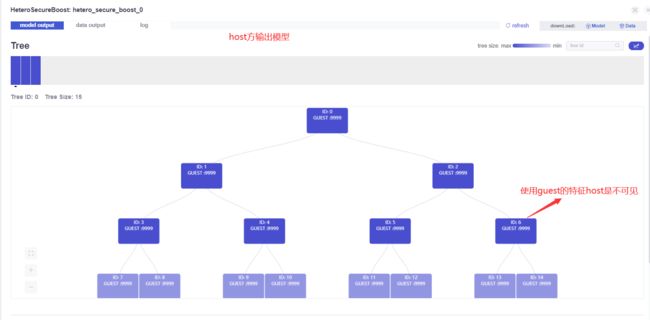- 医疗金融预测与语音识别中的模型优化及可解释性技术突破
智能计算研究中心
其他
内容概要随着人工智能技术的纵深发展,模型优化与可解释性技术正在重塑医疗诊断、金融预测及语音识别领域的应用范式。在医疗领域,基于自适应学习的动态参数调整机制,结合迁移学习的跨场景知识复用,显著提升了疾病筛查模型的泛化能力;而金融预测场景中,联邦学习框架通过分布式数据协作,在保障隐私安全的前提下,实现了风险预测模型的多维度优化。语音识别领域则依托边缘计算架构,将模型压缩技术与实时推理引擎结合,有效解决
- AI人工智能助力联邦学习通信效率优化的解决方案
AI智能应用
人工智能ai
AI驱动的联邦学习通信效率优化:从理论到实践的全面解决方案元数据框架标题AI驱动的联邦学习通信效率优化:从理论到实践的全面解决方案关键词联邦学习(FederatedLearning)、通信优化(CommunicationEfficiency)、AI赋能(AI-Enabled)、参数压缩(ParameterCompression)、客户端选择(ClientSelection)、联邦蒸馏(Federa
- 2022项目实训“异步分布式联邦学习”第五周报告
一、本周工作进度我在本周的工作进度主要集中于两个技术要点——即Axios和WebSocket。这两种技术方法有着本质上的不同,因而具体实现出来之后的效果也有所不同,下面将会分别说明。1.Axios(Ajax封装)首先要谈的内容是Axios,Axios是一个基于promise的HTTP库,是目前前端最流行的ajax请求库。Axios的优势在于,相比传统的Ajax本身是针对MVC的编程,Axios更加
- 三体融合实战:Django+讯飞星火+Colossal-AI的企业级AI系统架构
IT莫染
FunctionModuleAI大模型工具及插件django人工智能系统架构讯飞星火Colossal-AIWebSocket
目录技术栈关键词:Django5.0讯飞星火4.0UltraColossal-AI1.2WebSocket联邦学习⚡核心架构设计️一、Django深度集成讯飞星火API(免费版)1.获取API凭证2.流式通信改造(解决高并发阻塞)3.Django视图层集成⚡二、Colossal-AI加速多模型适配策略1.私有模型微调方案2.多模型路由逻辑三、私有化部署安全加固方案1.三重安全防护体系2.请求签名防
- 大模型在通讯网络中的系统性应用架构
Deepoch
网络
一、网络架构智能化重构1.1空天地一体化组网优化智能拓扑动态调整:大模型通过分析卫星轨道数据、地面基站负载及用户分布,实时优化天地一体化网络拓扑。例如,在用户密集区域(如城市中心)自动增强低轨卫星与地面基站的协同,通过联邦学习实现跨区域资源调度,降低跨空口传输时延至0.3ms以下。量子密钥分发增强:结合量子通信卫星星座,大模型动态生成抗量子攻击的密钥分发策略。在卫星间链路中,采用LSTM预测信道衰
- 入门pytorch-联邦学习
四代机您发多少
pytorch人工智能python
本文联邦学习的代码引用于https://github.com/shaoxiongji/federated-learning本篇文章相当于带大家读一遍联邦学习的代码,同时加深了大家对联邦学习和Pytorch框架的理解。这里想简单介绍一下联邦学习。联邦学习说白了,就是假如有NNN个数据拥有者F1,...,FN{F_1,...,F_N}F1,...,FN,他们希望使用这些数据来训练机器学习模型,但是又各
- 长尾形分布论文速览三十篇【60-89】
木木阳
Long-tailed人工智能
长尾形分布速览(60-89)这些研究展示了LLMs在长尾数据分布、持续学习、异常检测、联邦学习、对比学习、知识图谱、推荐系统、多目标跟踪、标签修复、对象检测、医疗生物医学以及其他应用中的广泛应用。通过优化和创新,LLMs在这些领域展现了卓越的性能,并为解决长尾问题提供了有效的工具和方法。1.长尾持续学习与对抗学习长尾持续学习(Paper60):通过优化器状态重用来减少遗忘,提高在长尾任务中的持续学
- 跨区域智能电网负荷预测:基于 PaddleFL 的创新探索
暮雨哀尘
人工智能智能电网AIGCPaddleFL数据库python可视化
跨区域智能电网负荷预测:基于PaddleFL的创新探索摘要:本文聚焦跨区域智能电网负荷预测,提出基于PaddleFL框架的联邦学习方法,整合多地区智能电网数据,实现数据隐私保护下的高精度预测,为电网调度优化提供依据,推动智能电网发展。一、引言在当今社会,电力作为经济发展的命脉,其稳定供应对于保障社会生活的正常运转和生产的持续进行具有不可替代的重要性。而智能电网作为现代电力系统的重要发展方向,通过集
- 面向隐私保护的机器学习:联邦学习技术解析与应用
Blossom.118
机器学习与人工智能机器学习人工智能深度学习tensorflowpython神经网络cnn
在当今数字化时代,数据隐私和安全问题日益受到关注。随着《数据安全法》《个人信息保护法》等法律法规的实施,企业和机构在数据处理和分析过程中面临着越来越严格的合规要求。然而,机器学习模型的训练和优化往往需要大量的数据支持,这就产生了一个矛盾:如何在保护数据隐私的前提下,充分利用数据的价值进行机器学习模型的训练和优化?联邦学习(FederatedLearning)作为一种新兴的隐私保护技术,为解决这一问
- 《多设备协同训练:HarmonyOS联邦学习驱动Unity游戏AI进化》
爱学习的小齐哥哥
HarmonyOS5Unity游戏HarmonyOS5unity游戏引擎Unity游戏
随着游戏产业的智能化升级,游戏AI正从传统的规则驱动向数据驱动的“自进化”模式转型。然而,传统游戏AI训练面临数据孤岛、计算资源受限、隐私安全风险三大核心挑战:单设备训练难以处理复杂场景的海量数据,集中式训练需上传用户行为数据(侵犯隐私),且高性能计算依赖云端或专用硬件(成本高、延迟大)。在此背景下,HarmonyOS联邦学习与多设备协同训练的融合,为Unity游戏AI的智能化进化提供了突破性解决
- AI人工智能加持,联邦学习医疗数据共享方案全解析
AI学长带你学AI
CS人工智能网络ai
AI人工智能加持,联邦学习医疗数据共享方案全解析关键词:联邦学习、医疗数据共享、隐私保护、人工智能、多方安全计算摘要:医疗数据是医学研究和临床决策的“黄金资源”,但患者隐私保护与数据孤岛问题却像两道高墙,阻碍着医疗AI的发展。本文将以“联邦学习”这一AI核心技术为钥匙,带您深入理解如何在不泄露原始数据的前提下,实现跨医院、跨机构的医疗数据共享与联合建模。我们将从生活场景出发,用“厨师合作研发新菜”
- 深度学习框架与联邦学习:探究未来的AI发展趋势=======================摘要:本文将深入探讨深度学习框架与联邦学习的融合,分析其在现代AI领域的应用和发展趋势。我们将介绍深度学习框
深度学习框架与联邦学习:探究未来的AI发展趋势摘要:本文将深入探讨深度学习框架与联邦学习的融合,分析其在现代AI领域的应用和发展趋势。我们将介绍深度学习框架的基本原理、联邦学习的概念及其优势,并结合实际案例探讨二者的结合如何推动AI技术的创新与发展。一、深度学习框架:AI的基石深度学习框架是构建和训练深度学习模型的重要工具。它为开发者提供了便捷的工具和库,使得构建复杂的神经网络模型变得更加简单高效
- 同态加密类型详解:部分同态加密,全同态加密
胡乱编胡乱赢
同态加密区块链算法部分同态全同态
一、部分同态加密(PHE)仅支持单一运算(加法或乘法),效率较高,已实用化。乘法同态算法:RSA:基于大数分解问题,满足E(m1)⋅E(m2)=E(m1⋅m2),适用于安全投票和数字签名。ElGamal:基于离散对数问题,支持乘法同态,常用于区块链隐私保护。加法同态算法:Paillier:基于合数剩余类问题,满足E(m1)⋅E(m2)=E(m1+m2),广泛用于联邦学习中的梯度聚合(如FATE框架
- 边缘计算算法与自动驾驶安全优化实践
智能计算研究中心
其他
内容概要在自动驾驶系统的安全优化进程中,边缘计算算法通过分布式算力部署与实时数据处理能力,为车辆决策层构建了低时延、高容错的技术底座。本文系统性分析联邦学习与生成对抗网络(GAN)的融合机制,在保护数据隐私的同时提升多节点模型的动态适应能力,并通过可解释性算法对决策逻辑进行可视化解析,增强系统透明度。针对复杂行车场景,数据预处理与特征工程的双向协同显著优化了障碍物识别与路径规划的鲁棒性,结合F1值
- 鹰盾视频的AI行为检测是怎样的风控?
加油搞钱加油搞钱
人工智能音视频
引言在数字内容生态与安全防护交织的复杂环境下,视频风控已成为保障平台合规运营、用户信息安全的核心防线。传统基于规则匹配与简单统计的风控手段,在面对多样化、隐蔽化的违规行为时逐渐力不从心。鹰盾视频构建的AI行为检测风控体系,通过深度融合多模态分析、强化学习、联邦学习等前沿技术,打造了从数据感知、智能研判到动态响应的全链条风控闭环。本文将从技术架构、核心算法、工程实践及未来演进等维度,深入解析其AI行
- 联邦学习:用隐私保护助力CIFAR10建模
AI天才研究院
计算AI大模型企业级应用开发实战ChatGPT计算科学神经计算深度学习神经网络大数据人工智能大型语言模型AIAGILLMJavaPython架构设计AgentRPA
联邦学习:用隐私保护助力CIFAR-10建模作者:禅与计算机程序设计艺术1.背景介绍1.1CIFAR-10数据集概述CIFAR-10数据集是一个广泛用于图像分类任务的基准数据集。它包含60,000张32x32彩色图像,分为10个类别,每个类别有6,000张图像。这些类别包括:飞机、汽车、鸟、猫、鹿、狗、青蛙、马、船和卡车。CIFAR-10数据集被广泛应用于图像分类算法的评估和比较。1.2传统机器学
- 基于Dirichlet分布的联邦学习数据分配
黑马算法创新
人工智能机器学习联邦学习异构联邦学习异构数据隐私保护
基于Dirichlet分布的联邦学习数据分配。其目标是将数据按照不均衡的方式分配到不同的客户端,模拟真实世界中客户端数据不均匀的情况。下面详细解释这段逻辑:标签排序和数据组织:首先,代码对数据集中的标签进行排序(labels_sorted)。这些标签代表着数据的类别。然后,通过将标签和相应的数据索引(即数据点的位置)配对,形成了一个名为class_by_labels的列表,每个元素是一个元组,其中
- 大模型训练新范式:隐私增强联邦学习架构与工程实践
尘烬海
架构rustwasmphp开发语言安全
一、传统联邦学习为何无法满足大模型隐私需求当前主流联邦学习框架如FedAvg在面对大模型时存在显著短板:python#标准FedAvg参数聚合伪代码暴露关键漏洞global_model=initialize_model()forroundinrange(total_rounds):client_updates=[]forclientinselected_clients:#本地训练梯度ΔW可被用于反
- 企业级大数据隐私保护:架构设计与实现方案
AI天才研究院
计算AI大模型应用入门实战与进阶AIAgent应用开发大数据ai
企业级大数据隐私保护:架构设计与实现方案关键词:大数据隐私保护、隐私计算、联邦学习、差分隐私、安全多方计算、数据合规、去标识化摘要:本文系统解析企业级大数据隐私保护的核心技术体系,从架构设计到具体实现方案展开深度探讨。通过分层架构设计覆盖数据全生命周期,结合差分隐私、联邦学习、安全多方计算等前沿技术,阐述数据收集、存储、处理、共享各环节的隐私保护机制。配套完整的数学模型推导、Python代码实现和
- 如何用数字人实现品效合一的传播
井云智能矩阵系统
人工智能
——从量子化建模到联邦学习的技术革命与商业实践一、行业痛点:传统营销的“三重割裂”2025年数据显示,78%的企业因营销效率低下错失市场机遇(快消品牌年损超500万元),核心矛盾聚焦于:品效割裂:品牌广告CTR<0.5%,效果广告复购率不足30%(MCN机构实测)渠道割裂:跨平台数据孤岛导致用户旅程断裂,转化漏斗流失率>65%人效割裂:真人主播日播极限4小时,人力成本占比超60%而如今,基于数字人
- 联邦学习架构深度分析:支持多家医院协作训练AI模型方案分析
Allen_Lyb
数智化医院2025架构人工智能
引言随着人工智能技术在医疗领域的广泛应用,医疗机构面临着如何在保护患者隐私的同时,高效利用分散在各医疗机构的医疗数据进行模型训练的挑战。传统的集中式数据共享方法不仅面临隐私泄露风险,还涉及复杂的法律合规问题。在这一背景下,"数据不动模型动"的联邦学习架构应运而生,为医疗机构提供了在不共享原始数据的前提下协同训练AI模型的新范式。联邦学习(FederatedLearning)是一种分布式机器学习范式
- **深度学习框架与生成对抗网络:探索前沿技术的融合之美**摘要:本文将深入探讨深度学习框架在生成对抗网络(GANs)中的应用,分析大模型训练的实践,并展望联邦学习在未来技术趋势中的位置。我们将通过实例
2401_89451588
深度学习生成对抗网络人工智能python
深度学习框架与生成对抗网络:探索前沿技术的融合之美摘要:本文将深入探讨深度学习框架在生成对抗网络(GANs)中的应用,分析大模型训练的实践,并展望联邦学习在未来技术趋势中的位置。我们将通过实例和代码片段展示相关技术细节,帮助读者更好地理解这些前沿技术。一、引言随着人工智能(AI)技术的飞速发展,深度学习框架作为实现AI的重要工具,已经成为研究的热点。生成对抗网络(GANs)作为深度学习领域的一个重
- 【论文阅读】Federated Large Language Model : A Position Paper
只说人话绝不装逼
联邦大模型论文阅读语言模型人工智能
https://arxiv.org/pdf/2307.08925.pdf这篇文章算是一篇positionpaper,阐述了作者对联邦大模型的理解与看大。初学者可以当一篇综述来看。文章思想很朴素,也很容易理解,基本就是有大模型基础和联邦学习基础的人都能想到或是理解的。联邦大模型的两种学习方式两种非常直观的方法:一种是从头训练,一种是利用私有数据集进行微调。优劣也非常直观:第一种方法允许特定任务的模型
- 基于大模型预测视神经脊髓炎的技术方案
LCG元
大模型医疗研究-技术方向技术方案人工智能
目录一、摘要二、系统架构设计1.整体架构图(Mermaid流程图)2.子系统划分三、核心算法实现1.术前风险预测模型(伪代码示例)2.术中实时监测流程图四、系统集成方案1.硬件部署拓扑图2.关键API定义五、硬件集成方案1.计算资源规划2.安全通信协议六、技术验证方法1.模型验证流程2.对比实验设计七、附录1.联邦学习协调算法2.系统部署检查清单一、摘要本研究提出一种基于多模态大模型的视神经脊髓炎
- 自动化学习与边缘计算融合驱动语音识别模型优化新路径
智能计算研究中心
其他
内容概要当前,自动化机器学习与边缘计算技术的交叉融合正在重塑语音识别模型的研发范式。这一趋势的核心在于通过算法优化与算力下沉的双重路径,解决传统云端集中式训练面临的效率瓶颈与隐私风险。以联邦学习框架为基础的数据协同机制,使得分散在边缘设备中的语音样本能够在不共享原始数据的前提下参与模型迭代,有效平衡了数据利用与隐私保护之间的矛盾。与此同时,超参数自动化搜索技术通过贝叶斯优化、进化算法等策略,显著降
- 大白话解释联邦学习
frostmelody
深度学习小知识点机器学习小知识点人工智能联邦学习
数据孤岛:为何发生?有何危害?如何解决?什么是数据孤岛?企业或组织内部,数据因存储分散、标准不一、系统或部门壁垒,导致数据像一座座孤立的岛屿,无法自由流通与整合,其潜在价值难以被充分挖掘。例如,财务部和销售部各自使用独立数据库,数据无法自动交互,需手动导出导入(物理性孤岛)相同数据在不同部门被赋予不同含义。例如,销售部的“客户”指已成交用户,而市场部的“客户”包含潜在用户,导致跨部门协作时需反复沟
- 国际应用人工智能协会(IAAAI)的技术生态构建与全球实践
feng99520
人工智能重构AAIAIAAAIAI
一、组织架构与技术治理模型1.1跨学科协同机制IAAAI构建了独特的"三角协作框架"(TriangularCollaborationFramework),将学术界、产业界和政策制定者的需求整合为可编程的协作协议。其学术委员会与全球120个研究机构建立了动态知识图谱系统,通过语义网技术实时追踪联邦学习、边缘计算等18个技术领域的最新突破。例如,在2022年发布的联邦医疗成像协作平台(FMICP)中,
- 联邦学习图像分类实战:基于FATE与PyTorch的隐私保护机器学习系统构建指南
Tech Synapse
机器学习分类pytorch
引言在数据孤岛与隐私保护需求并存的今天,联邦学习(FederatedLearning)作为分布式机器学习范式,为医疗影像分析、金融风控、智能交通等领域提供了创新解决方案。本文将基于FATE框架与PyTorch深度学习框架,详细阐述如何构建一个支持多方协作的联邦学习图像分类平台,覆盖环境配置、数据分片、模型训练、隐私保护效果评估等全流程,并提供可直接运行的完整代码。一、技术架构与核心组件1.1联邦学
- MCP协议:大模型与外部工具交互的标准化创新方案
未来创世纪
AIGC人工智能
MCP协议:大模型与外部工具交互的标准化创新方案摘要:本文深入剖析MCP(ModelContextProtocol)协议,作为大模型与外部工具交互的标准化方案,其通过客户端-服务端架构实现AI能力与数据/工具的深度集成。文章从协议定位、架构设计和组件职责等维度展开,阐述其打破生态孤岛、降低开发复杂性、提升人机交互效率等核心价值,并探讨多模态扩展、联邦学习等未来演进方向,为AI系统构建提供重要参考。
- AI产品设计:如何平衡上下文理解与用户隐私?
AI大模型应用之禅
人工智能ai
AI产品设计:如何平衡上下文理解与用户隐私?关键词:AI产品设计、上下文理解、用户隐私、数据安全、隐私保护、差分隐私、联邦学习摘要:本文探讨了在AI产品设计中如何平衡上下文理解能力与用户隐私保护这一关键问题。我们将从基础概念出发,分析两者之间的冲突与协同关系,介绍当前主流的隐私保护技术,并通过实际案例展示如何在产品设计中实现这一平衡。文章最后展望了未来发展趋势,为AI产品设计师和开发者提供实用的指
- ASM系列四 利用Method 组件动态注入方法逻辑
lijingyao8206
字节码技术jvmAOP动态代理ASM
这篇继续结合例子来深入了解下Method组件动态变更方法字节码的实现。通过前面一篇,知道ClassVisitor 的visitMethod()方法可以返回一个MethodVisitor的实例。那么我们也基本可以知道,同ClassVisitor改变类成员一样,MethodVIsistor如果需要改变方法成员,注入逻辑,也可以
- java编程思想 --内部类
百合不是茶
java内部类匿名内部类
内部类;了解外部类 并能与之通信 内部类写出来的代码更加整洁与优雅
1,内部类的创建 内部类是创建在类中的
package com.wj.InsideClass;
/*
* 内部类的创建
*/
public class CreateInsideClass {
public CreateInsideClass(
- web.xml报错
crabdave
web.xml
web.xml报错
The content of element type "web-app" must match "(icon?,display-
name?,description?,distributable?,context-param*,filter*,filter-mapping*,listener*,servlet*,s
- 泛型类的自定义
麦田的设计者
javaandroid泛型
为什么要定义泛型类,当类中要操作的引用数据类型不确定的时候。
采用泛型类,完成扩展。
例如有一个学生类
Student{
Student(){
System.out.println("I'm a student.....");
}
}
有一个老师类
- CSS清除浮动的4中方法
IT独行者
JavaScriptUIcss
清除浮动这个问题,做前端的应该再熟悉不过了,咱是个新人,所以还是记个笔记,做个积累,努力学习向大神靠近。CSS清除浮动的方法网上一搜,大概有N多种,用过几种,说下个人感受。
1、结尾处加空div标签 clear:both 1 2 3 4
.div
1
{
background
:
#000080
;
border
:
1px
s
- Cygwin使用windows的jdk 配置方法
_wy_
jdkwindowscygwin
1.[vim /etc/profile]
JAVA_HOME="/cgydrive/d/Java/jdk1.6.0_43" (windows下jdk路径为D:\Java\jdk1.6.0_43)
PATH="$JAVA_HOME/bin:${PATH}"
CLAS
- linux下安装maven
无量
mavenlinux安装
Linux下安装maven(转) 1.首先到Maven官网
下载安装文件,目前最新版本为3.0.3,下载文件为
apache-maven-3.0.3-bin.tar.gz,下载可以使用wget命令;
2.进入下载文件夹,找到下载的文件,运行如下命令解压
tar -xvf apache-maven-2.2.1-bin.tar.gz
解压后的文件夹
- tomcat的https 配置,syslog-ng配置
aichenglong
tomcathttp跳转到httpssyslong-ng配置syslog配置
1) tomcat配置https,以及http自动跳转到https的配置
1)TOMCAT_HOME目录下生成密钥(keytool是jdk中的命令)
keytool -genkey -alias tomcat -keyalg RSA -keypass changeit -storepass changeit
- 关于领号活动总结
alafqq
活动
关于某彩票活动的总结
具体需求,每个用户进活动页面,领取一个号码,1000中的一个;
活动要求
1,随机性,一定要有随机性;
2,最少中奖概率,如果注数为3200注,则最多中4注
3,效率问题,(不能每个人来都产生一个随机数,这样效率不高);
4,支持断电(仍然从下一个开始),重启服务;(存数据库有点大材小用,因此不能存放在数据库)
解决方案
1,事先产生随机数1000个,并打
- java数据结构 冒泡排序的遍历与排序
百合不是茶
java
java的冒泡排序是一种简单的排序规则
冒泡排序的原理:
比较两个相邻的数,首先将最大的排在第一个,第二次比较第二个 ,此后一样;
针对所有的元素重复以上的步骤,除了最后一个
例题;将int array[]
- JS检查输入框输入的是否是数字的一种校验方法
bijian1013
js
如下是JS检查输入框输入的是否是数字的一种校验方法:
<form method=post target="_blank">
数字:<input type="text" name=num onkeypress="checkNum(this.form)"><br>
</form>
- Test注解的两个属性:expected和timeout
bijian1013
javaJUnitexpectedtimeout
JUnit4:Test文档中的解释:
The Test annotation supports two optional parameters.
The first, expected, declares that a test method should throw an exception.
If it doesn't throw an exception or if it
- [Gson二]继承关系的POJO的反序列化
bit1129
POJO
父类
package inheritance.test2;
import java.util.Map;
public class Model {
private String field1;
private String field2;
private Map<String, String> infoMap
- 【Spark八十四】Spark零碎知识点记录
bit1129
spark
1. ShuffleMapTask的shuffle数据在什么地方记录到MapOutputTracker中的
ShuffleMapTask的runTask方法负责写数据到shuffle map文件中。当任务执行完成成功,DAGScheduler会收到通知,在DAGScheduler的handleTaskCompletion方法中完成记录到MapOutputTracker中
- WAS各种脚本作用大全
ronin47
WAS 脚本
http://www.ibm.com/developerworks/cn/websphere/library/samples/SampleScripts.html
无意中,在WAS官网上发现的各种脚本作用,感觉很有作用,先与各位分享一下
获取下载
这些示例 jacl 和 Jython 脚本可用于在 WebSphere Application Server 的不同版本中自
- java-12.求 1+2+3+..n不能使用乘除法、 for 、 while 、 if 、 else 、 switch 、 case 等关键字以及条件判断语句
bylijinnan
switch
借鉴网上的思路,用java实现:
public class NoIfWhile {
/**
* @param args
*
* find x=1+2+3+....n
*/
public static void main(String[] args) {
int n=10;
int re=find(n);
System.o
- Netty源码学习-ObjectEncoder和ObjectDecoder
bylijinnan
javanetty
Netty中传递对象的思路很直观:
Netty中数据的传递是基于ChannelBuffer(也就是byte[]);
那把对象序列化为字节流,就可以在Netty中传递对象了
相应的从ChannelBuffer恢复对象,就是反序列化的过程
Netty已经封装好ObjectEncoder和ObjectDecoder
先看ObjectEncoder
ObjectEncoder是往外发送
- spring 定时任务中cronExpression表达式含义
chicony
cronExpression
一个cron表达式有6个必选的元素和一个可选的元素,各个元素之间是以空格分隔的,从左至右,这些元素的含义如下表所示:
代表含义 是否必须 允许的取值范围 &nb
- Nutz配置Jndi
ctrain
JNDI
1、使用JNDI获取指定资源:
var ioc = {
dao : {
type :"org.nutz.dao.impl.NutDao",
args : [ {jndi :"jdbc/dataSource"} ]
}
}
以上方法,仅需要在容器中配置好数据源,注入到NutDao即可.
- 解决 /bin/sh^M: bad interpreter: No such file or directory
daizj
shell
在Linux中执行.sh脚本,异常/bin/sh^M: bad interpreter: No such file or directory。
分析:这是不同系统编码格式引起的:在windows系统中编辑的.sh文件可能有不可见字符,所以在Linux系统下执行会报以上异常信息。
解决:
1)在windows下转换:
利用一些编辑器如UltraEdit或EditPlus等工具
- [转]for 循环为何可恨?
dcj3sjt126com
程序员读书
Java的闭包(Closure)特征最近成为了一个热门话题。 一些精英正在起草一份议案,要在Java将来的版本中加入闭包特征。 然而,提议中的闭包语法以及语言上的这种扩充受到了众多Java程序员的猛烈抨击。
不久前,出版过数十本编程书籍的大作家Elliotte Rusty Harold发表了对Java中闭包的价值的质疑。 尤其是他问道“for 循环为何可恨?”[http://ju
- Android实用小技巧
dcj3sjt126com
android
1、去掉所有Activity界面的标题栏
修改AndroidManifest.xml 在application 标签中添加android:theme="@android:style/Theme.NoTitleBar"
2、去掉所有Activity界面的TitleBar 和StatusBar
修改AndroidManifes
- Oracle 复习笔记之序列
eksliang
Oracle 序列sequenceOracle sequence
转载请出自出处:http://eksliang.iteye.com/blog/2098859
1.序列的作用
序列是用于生成唯一、连续序号的对象
一般用序列来充当数据库表的主键值
2.创建序列语法如下:
create sequence s_emp
start with 1 --开始值
increment by 1 --増长值
maxval
- 有“品”的程序员
gongmeitao
工作
完美程序员的10种品质
完美程序员的每种品质都有一个范围,这个范围取决于具体的问题和背景。没有能解决所有问题的
完美程序员(至少在我们这个星球上),并且对于特定问题,完美程序员应该具有以下品质:
1. 才智非凡- 能够理解问题、能够用清晰可读的代码翻译并表达想法、善于分析并且逻辑思维能力强
(范围:用简单方式解决复杂问题)
- 使用KeleyiSQLHelper类进行分页查询
hvt
sql.netC#asp.nethovertree
本文适用于sql server单主键表或者视图进行分页查询,支持多字段排序。KeleyiSQLHelper类的最新代码请到http://hovertree.codeplex.com/SourceControl/latest下载整个解决方案源代码查看。或者直接在线查看类的代码:http://hovertree.codeplex.com/SourceControl/latest#HoverTree.D
- SVG 教程 (三)圆形,椭圆,直线
天梯梦
svg
SVG <circle> SVG 圆形 - <circle>
<circle> 标签可用来创建一个圆:
下面是SVG代码:
<svg xmlns="http://www.w3.org/2000/svg" version="1.1">
<circle cx="100" c
- 链表栈
luyulong
java数据结构
public class Node {
private Object object;
private Node next;
public Node() {
this.next = null;
this.object = null;
}
public Object getObject() {
return object;
}
public
- 基础数据结构和算法十:2-3 search tree
sunwinner
Algorithm2-3 search tree
Binary search tree works well for a wide variety of applications, but they have poor worst-case performance. Now we introduce a type of binary search tree where costs are guaranteed to be loga
- spring配置定时任务
stunizhengjia
springtimer
最近因工作的需要,用到了spring的定时任务的功能,觉得spring还是很智能化的,只需要配置一下配置文件就可以了,在此记录一下,以便以后用到:
//------------------------定时任务调用的方法------------------------------
/**
* 存储过程定时器
*/
publi
- ITeye 8月技术图书有奖试读获奖名单公布
ITeye管理员
活动
ITeye携手博文视点举办的8月技术图书有奖试读活动已圆满结束,非常感谢广大用户对本次活动的关注与参与。
8月试读活动回顾:
http://webmaster.iteye.com/blog/2102830
本次技术图书试读活动的优秀奖获奖名单及相应作品如下(优秀文章有很多,但名额有限,没获奖并不代表不优秀):
《跨终端Web》
gleams:http












